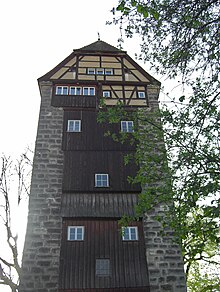Five-button tower and lower gate
The Fünfknopfturm (also Fünfknöpflesturm ) and the upstream him Lower Gate were parts in the northwestern part of the outer fortification of Schwabisch Gmund . They formed a kind of fortress . The former gate guard house is also located in this area .
Five button tower
The five-button tower is a defensive tower with a pentagonal floor plan , which turns away from the city like a bow. The name comes from the five button-like attachments that are attached to each of the three bay-like turrets on the roof of the tower and two on the hipped roof of the tower. This distinguishes it from most of the other Gothic five-button towers , which usually have four watch towers on the corners. The tower was built at the beginning of the 15th century, probably between 1423 and 1425, from humpback ashlars. The half- gable is designed in half-timbered construction. In the 16th century the roof bay windows were added, which give the tower its characteristic appearance today. For many years, until the 20th century, the tower served as a fire watch tower . Until 2003 the tower was rented privately and the tower apartment was inhabited.
There were repeated repair and renovation work on the tower. In 1930 the copper buttons were replaced after a lightning strike . In 1933 and in the 1960s, the wooden cladding on the east side was replaced. In 1958 the west side was renovated and in 1959 a transformer station was built into the tower. In 1967 the tower received a new bell in its iron roof attachment with a weather vane after the old bell had to be given in in 1942. The bell that was handed in was from 1531 and was cast by Leonhard Friedler in Esslingen am Neckar . It had a height of 45 cm and a diameter of 52 cm and bore the inscription in German script: 1531 gos mich leonhart fridler zu eslingen got sein praised . Next to it was: wergl + bert + gos + mirs + vi + imperial + steir + ufz + decemb + Carolus / Rome.
The last extensive renovation of the tower was carried out in 2014/2013 for the State Garden Show Schwäbisch Gmünd 2014 .
Lower gate
The lower gate ( location ) was in front of the five-button tower and is largely no longer visible today. It was built in the late 15th century or early 16th century, and most of it was demolished in 1811. Today's descriptions of the structure are only possible based on the notes made by Dominikus Debler . It was probably a double tower complex, each with semicircular to three-quarter-round, three-storey towers and a rectangular gate passage in between. The gate system was partly designed as a half-timbered building .
It is known that the coat of arms that showed the Gmünd city coat of arms was knocked off in 1803 and replaced by a painted panel with the coat of arms of Württemberg . In 1964, parts of the structure were destroyed when post shafts were built on the northern edge.
In the course of the renovation work in the context of the State Garden Show 2014, the car bridge was dismantled to a pedestrian bridge and in 2013 parts of the remains of the Lower Gate were exposed again. The defensive corridors in this area were rediscovered, as was the main corridor to the five-button tower. However, these were still known to the older population as so-called robber caves . Today, the remains and the old parts of the bridge are visible and accessible again.
Gatekeeping house
The gate guard house ( location ) was built in its current form in 1828/1829 as a new building at the western end of the bridge over the Josephsbach , after there were plans for it as early as 1827. In 1837 the wooden pillars were replaced by stone pillars. As early as September 4, 1773, the city chronicler Dominikus Debler mentioned a guard house, as the city administration had to pay a basic rent to the Gmünder hospital for a garden here .
The gable-independent , late Classicist , single-storey building has a representative, four-part columned portico with Doric columns and an image of the Gmünder city coat of arms in the gable. The Torwachthäuschen long served as a taxi office and was renovated for the State Garden Show in 2014 and converted to gastronomic purposes.
It is the second surviving gate guard house next to the gate guard house on the Waldstetter bridge in Schwäbisch Gmünd.
literature
- Richard Strobel, State Monuments Office Baden-Württemberg: The art monuments of the city of Schwäbisch Gmünd . Volume 1, City Building History, City Fortifications, Heiligkreuzmünster; Deutscher Kunstverlag, Munich 2003; ISBN 3-422-06381-1 , pp. 145-151.
Web links
- Five button tower on schwaebisch-gmuend.de
Individual evidence
- ↑ Richard Strobel 2003, p. 151 describes the area as a group .
- ↑ Five- button tower and arched bridge , in the series Gartenschauplätz by the magazine schau.gmünd on the State Garden Show 2014 on remszeitung.de.
- ↑ Refurbishment of the five-button tower completed ( memento from September 23, 2016 in the Internet Archive ) . In: Gmünder Tagespost from April 30, 2014.
- ↑ The underground fortress on the five-button tower now partially exposed , article on remszeitung.de from November 20, 2013.
Coordinates: 48 ° 47 '58.2 " N , 9 ° 47' 32.9" E




